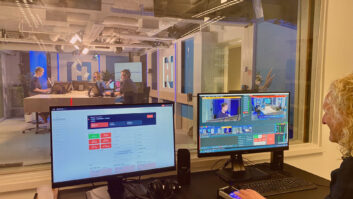Radio’s ability to adapt and compete in the multi-platform digital world is a major concern for broadcasters worldwide. Abe Thomas, CEO of India’s BIG FM, provided delegates to the Radiodays Asia conference with tangible ways to make this happen during his “Transformation of Radio” presentation. The in-person/online conference was held September 6-7, 2022 at Malaysia’s Shangri-La Kuala Lumpur hotel. Radiodays Asia is a collaboration between the Radiodays Europe conference and broadcasting partners in Asia and Australia.
Radio Driving Digital Audio
In opening his remarks, Thomas noted that the success of online digital audio services “is being driven by radio-like experiences.” He added that the changes that have occurred in online audio consumption over the last 20 years have actually led digital audio content production back to radio.
“What’s actually changed, from a media consumption and creation point of view, is that the web made content virtual,” said Thomas. “Search engines made it searchable. Social media made it shareable. Mobiles made it responsive and interactive. And now the search is for immersive content — and nobody makes immersive content better than radio.”
There’s a very good reason why digital audio content producers are mining broadcast radio for audience-grabbing ideas. “Radio’s biggest strength is its ability to create great connections,” said Thomas. “It’s about building communities: How do we keep building communities by keeping the consumer first and creating great memorable content by distribution of that content everywhere — making sure it’s available wherever the consumer chooses to listen?”
This being said, Thomas believes that radio must take tangible steps to stake out, hold and expand its territory in the online space. Reflecting on his own corporate experience, Thomas said, “I must clarify here that BIG Radio, which is our 58–station radio network, still gets me 95% of my revenue. But given the growth of digital audio [and] given the realization of the importance of audio by brands, we are projecting that this [sector] might grow to about 25% of our business in the next two years. So we have come up with a lot of solutions around audio, which as a radio network, we are able to provide.”
[For News on This and Other Shows See Our Show News Page]
BIG Solutions
In order to thrive in the digital audio space, BIG FM has created a number of distinctive audio brands. One of these is BIG LIVE, which specializes in on-site and online live concerts. The company’s flagship venue is BIG Café. It has been offering online concerts for the past two years.
BIG Social operates in social media. This is where BIG FM partners with socially conscious brands who promote sustainability and inclusivity.
BIG Advocacy is “responsible for selling away our mentions to brands, very cheap,” said Thomas. To do this effectively, BIG FM works with 100-plus ‘influencers’, he told attendees and online viewers. “So as a solution, we’re able to offer our clients BIG Advocacy packages through which they can actually use influencer marketing tools to communicate their messages.”
Other online initiatives include BIG Games, “where you’re actually able to generate leads for clients through a series of games that they play on radio and online,” said Thomas, and BIG Voice, which is BIG FM’s bank of 300-plus podcasts in 19 languages. This last offering is aimed at smart speakers. For instance, the smart speaker version of BIG FM’s “What’s for Dinner?” program allows the listener to “actually interact with the speaker and get solutions to what you want to cook that evening,” he said.
Time to Band Together
Having outlined the many ways that BIG FM is venturing into the digital audio space, Abe Thomas warned that the share of advertising dollars being allocated to radio is shrinking. This means that the days of destructive inter-broadcaster competition has to end if the industry is to survive. “Think of collaboration and partnerships,” he advised.
The reason? “Digital is probably the fastest growing section of our media,” said Thomas.
“It has overtaken print in India, is almost on par with radio or television, and is expected to grow beyond that. But over 75% of the revenue of digital is taken by two companies. The third biggest chunk are the TV broadcasters with their video and their OTT play. So the amount of money that everybody else is playing for in the digital (audio space) is probably 10 to 15% of that ad pie. It’s a hugely fragmented play.”
The bottom line: “Digital audio consumption is exploding,” he concluded. “But the revenues are small.” This is why it is time for radio broadcasters in India and other places to band together in order to survive and thrive.











